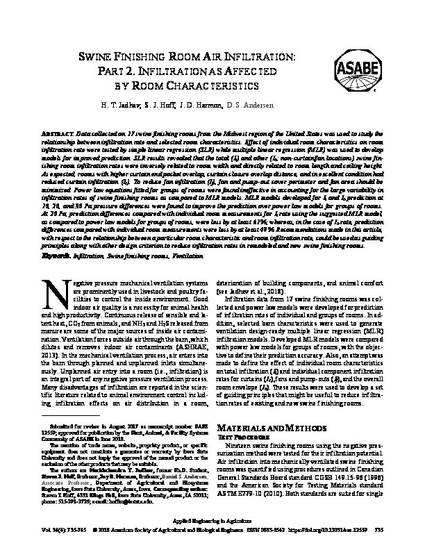
Data collected on 17 swine finishing rooms from the Midwest region of the United States was used to study the relationship between infiltration rate and selected room characteristics. Effect of individual room characteristics on room infiltration rate were tested by simple linear regression (SLR) while multiple linear regression (MLR) was used to develop models for improved prediction. SLR results revealed that the total (It) and other (Io; non-curtain/fan locations) swine finishing room infiltration rates were inversely related to room width and directly related to room length and ceiling height. As expected, rooms with higher curtain end pocket overlap, curtain closure overlap distance, and in excellent condition had reduced curtain infiltration (Ic). To reduce fan infiltration (If), fan and pump-out cover perimeter and fan area should be minimized. Power law equations fitted for groups of rooms were found ineffective in accounting for the large variability in infiltration rates of swine finishing rooms as compared to MLR models. MLR models developed for It and Io prediction at 10, 20, and 30 Pa pressure differences were found to improve the prediction over power law models for groups of rooms. At 20 Pa, prediction differences compared with individual room measurements for It rate using the suggested MLR model, as compared to power law models for groups of rooms, were less by at least 61%; whereas, in the case of Io rate, prediction differences compared with individual room measurements were less by at least 49%. Recommendations made in this article, with respect to the relationship between a particular room characteristic and room infiltration rate, could be used as guiding principles along with other design criterion to reduce infiltration rates in remodeled and new swine finishing rooms.
Available at: http://works.bepress.com/steven_hoff/163/

This article is published as Jadhav, Harishchandra T., Steven J. Hoff, Jay D. Harmon, and Daniel S. Andersen. "Swine Finishing Room Air Infiltration: Part 2. Infiltration as Affected by Room Characteristics." Applied Engineering in Agriculture 34, no. 4 (2018): 735-745. DOI: 10.13031/aea.12559. Posted with permission.